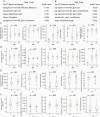Radiomic analysis of magnetic resonance imaging predicts brain metastases velocity and clinical outcome after upfront radiosurgery
- PMID: 33817641
- PMCID: PMC8008166
- DOI: 10.1093/noajnl/vdaa100
Radiomic analysis of magnetic resonance imaging predicts brain metastases velocity and clinical outcome after upfront radiosurgery
Abstract
Background: Brain metastasis velocity (BMV) predicts outcomes after initial distant brain failure (DBF) following upfront stereotactic radiosurgery (SRS). We developed an integrated model of clinical predictors and pre-SRS MRI-derived radiomic scores (R-scores) to identify high-BMV (BMV-H) patients upon initial identification of brain metastases (BMs).
Methods: In total, 256 patients with BMs treated with upfront SRS alone were retrospectively included. R-scores were built from 1246 radiomic features in 2 target volumes by using the Extreme Gradient Boosting algorithm to predict BMV-H groups, as defined by BMV at least 4 or leptomeningeal disease at first DBF. Two R-scores and 3 clinical predictors were integrated into a predictive clinico-radiomic (CR) model.
Results: The related R-scores showed significant differences between BMV-H and low BMV (BMV-L), as defined by BMV less than 4 or no DBF (P < .001). Regression analysis identified BMs number, perilesional edema, and extracranial progression as significant predictors. The CR model using these 5 predictors achieved a bootstrapping corrected C-index of 0.842 and 0.832 in the discovery and test sets, respectively. Overall survival (OS) after first DBF was significantly different between the CR-predicted BMV-L and BMV-H groups (median OS: 26.7 vs 13.0 months, P = .016). Among patients with a diagnosis-specific graded prognostic assessment of 1.5-2 or 2.5-4, the median OS after initial SRS was 33.8 and 67.8 months for CR-predicted BMV-L, compared to 13.5 and 31.0 months for CR-predicted BMV-H (P < .001 and <.001), respectively.
Conclusion: Our CR model provides a novel approach showing good performance to predict BMV and clinical outcomes.
Keywords: brain metastases velocity; distant brain failure; machine learning; neuro-oncology; radiomics.
© The Author(s) 2020. Published by Oxford University Press, the Society for Neuro-Oncology and the European Association of Neuro-Oncology.
Figures




References
-
- Scoccianti S, Ricardi U. Treatment of brain metastases: review of phase III randomized controlled trials. Radiother Oncol. 2012;102(2):168–179. - PubMed
-
- Aoyama H, Shirato H, Tago M, et al. Stereotactic radiosurgery plus whole-brain radiation therapy vs stereotactic radiosurgery alone for treatment of brain metastases: a randomized controlled trial. JAMA. 2006;295(21):2483–2491. - PubMed
-
- Chang EL, Wefel JS, Hess KR, et al. Neurocognition in patients with brain metastases treated with radiosurgery or radiosurgery plus whole-brain irradiation: a randomised controlled trial. Lancet Oncol. 2009;10(11):1037–1044. - PubMed
LinkOut - more resources
Full Text Sources
